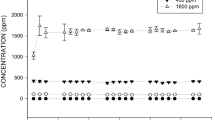Abstract
Metabolism of isobutene (2-methylpropene) in rats (Sprague Dawley) and mice (B6C3F1) follows kinetics according to Michaelis-Menten. The maximal metabolic elimination rates are 340 μmol/kg/h for rats and 560 μmol/kg/h for mice. The atmospheric concentration at which Vmax/2 is reached is 1200 ppm for rats and 1800 ppm for mice. At steady state, below atmospheric concentrations of about 500 ppm the rate of metabolism of isobutene is direct proportional to its concentration. 1,1-Dimethyloxirane is formed as a primary reactive intermediate during metabolism of isobutene in rats and can be detected in the exhaled air of the animals. Under conditions of saturation of isobutene metabolism the concentration of 1,1-dimethyloxirane in the atmosphere of a closed exposure system is only about 1/15 of that observed for ethene oxide and about 1/100 of that observed for 1,2-epoxy-3-butene as intermediates in the metabolism of ethene or 1,3-butadiene.
Similar content being viewed by others
References
Bolt HM, Filser JG (1987) Kinetics and disposition in toxicology example: carcinogenic risk estimate for ethylene. Arch Toxicol 60: 73–76
Bolt HM, Filser JG, Störmer F (1984) Inhalation pharmacokinetics based on gas uptake studies, V. Comparative pharmacokinetics of ethylene and 1,3-butadiene in rats. Arch Toxicol 55: 213–218
Canter DA, Zeiger E, Haworth S, Lawlor T, Mortelmans K, Speck W (1986) Comparative mutagenicity of aliphatic epoxides in salmonella. Mutat Res 172: 105–138
Cornet M, Sonck W, Callaerts A, Csanády G, Vercruysse A, Laib R, Rogiers V (1991) In vitro biotransformation of 2-methylpropene (isobutene): epoxide formation in mice liver. Arch Toxicol (submitted)
Deutschmann S, Laib RJ (1989) Concentration dependent depletion of non-protein sulfhydryl (NPSH) content in lung, heart and liver tissue of rats and mice after acute inhalation exposure to butadiene. Toxicol Lett 45: 145–183
Dunkelberg H (1982) Carcinogenicity of ethylene oxide and 1,2-propylene oxide upon intragastric administration to rats. Br J Cancer 46: 924–933
Filser JG, Bolt HM (1979) Pharmacokinetics of halogenated ethylenes in rats, Arch Toxicol 42: 123–136
Filser JG, Bolt HM (1981) Inhalation pharmacokinetics based on gas uptake studies, I. Improvement of kinetic models. Arch Toxicol 47: 279–292
Filser JG, Bolt HM (1983a) Exhalation of ethylene oxide by rats on exposure to ethylene. Mutat Res 120: 57–60
Filser JG, Bolt HM (1983b) Inhalation pharmacokinetics based on gas uptake studies, IV. The endogenous production of volatile compounds. Arch Toxicol 52: 123–133
Filser JG, Bolt HM (1984) Inhalation pharmacokinetics based on gas uptake studies, VI. Comparative evaluation of ethylene oxide and butadiene monoxide as exhaled reactive metabolites of ethylene and 1,3-butadiene in rats. Arch Toxicol 55: 219–223
Frank H, Hintze T, Bimboes D, Remmer H (1980) Monitoring lipid peroxidation by breath analysis: endogenous hydrocarbons and their metabolic elimination. Toxicol Appl Pharmacol 56: 337–344
Garrison JP, Bruice TC (1989) Intermediates in the epoxidation of alkenes by cytochrome P-450 models. J Am Chem Soc 111: 191–198
Golka K, Peter H, Denk B, Filser JG (1989) Pharmacokinetics of propylene and its reactive metabolite propylene oxide in Sprague-Dawley rats. Arch Toxicol Suppl 13: 240–242
Guengerich JP, Liebler DC (1985) Enzymatic activation of chemicals to toxic metabolites. CRC Crit Rev Toxicol 14: 259–307
Huff JE, Melnick RL, Solleveld HA, Haseman JK, Power SM, Miller RA (1985) Multiple organ carcinogenicity of 1,3-butadiene in B6C3F1 mice after 60 weeks of inhalation exposure. Science 227: 548–549
Kessler W, Denk B, Filser JG (1989) Species-specific inhalation pharmacokinetics of 2-nitropropane, methyl-ethyl-ketone and n-hexane. In: Travis CC (ed) Biologically-based methods for cancer risk assessment. Plenum Publishing Corporation 1989: 123–139
Kreiling R, Laib RJ, Filser JG, Bolt HM (1986) Species differences in butadiene metabolism between mice and rats evaluated by inhalation pharmacokinetics. Arch Toxicol 58: 235–238
Laib RJ, Csanády G (1990) Metabolic transformation of substituted alkenes — a theoretical chemical approach. The Toxicologist 10: 325
Laib RJ, Hindermeier U, Cornet M, Rogiers V (1990) Metabolism and toxicology of 2-methylpropene (isobutene): Comparison to other alkenes. Naunyn Schmiedeberg's Arch Pharmacol 341 (Suppl): R10
Laib RJ, Deutschman S, Jelitto B, Vangala RR, Kreiling R (1989) Species differences in pharmacokinetics, metabolism and DNA binding of inhaled 1,3-butadiene. In: Mohr U (ed) Assessment of inhalation hazards. Springer Verlag, Berlin, Heidelberg, New York, pp 189–199
Long FA, Pritchard JG (1956) Kinetics and mechanism of the acid-catalyzed hydrolysis of substituted ethylene oxides. J Am Chem Soc 78: 2667–2670
Melnick RL, Huff JE, Miller RA (1989) Toxicology and carcinogenicity of 1,3-butadiene. In: Mohr U (ed) Assessment of inhalation hazards. Springer Verlag, Berlin, Heidelberg, New York, pp 177–188
de Meester C, Poncelet F, Roberfroid M, Mercier M (1978) Mutagenicity of butadiene and butadiene monoxide. Biochem Biophys Res Commun 80: 298–305
Peter H, Wiegand HJ, Bolt HM, Greim H, Walter G, Berg M, Filser JG (1987) Pharmacokinetics of isoprene in mice and rats. Toxicol Lett 36: 9–14
Phalen RF (1983) Animal models. In: Inhalation studies formation and techniques. CRC Press Inc., Florida 211–241
Rekker RF, de Kort HM (1979) The hydrophobic fragmental constant; an extension to a 1000 data point set. Eur J Med Chem 14: 479–488
Sato A, Nakajima T (1979) Partition coefficients of some aromatic hydrocarbons and ketones in water, blood and oil. Br J Ind Med 36: 231–234
Shimizu H, Suzuki Y, Takemura N, Goto S, Matsushita H (1985) The results of microbial mutation tests for forty-three industrial chemicals. Jpn J Ind Health 27: 400–419
Shugaev BB, Yaroslavl BSc (1969) Concentrations of hydrocarbons in tissues as a measure of toxicity. Arch Environ Health 18: 878–882
Staab RJ, Sarginson NJ (1984) Lack of genetic toxicity of isobutylene gas. Mutat Res 130: 259–260
Ullmann's Encyclopedia of Industrial Chemistry, 5th Edn, Vol A4. VCH Verlagsgesellschaft mbH, Weinheim, 1985
Walker CH (1978) Species differences in microsomal monooxygenase activity and their relationship to biological half-lives. Drug Metab Rev 7: 295–323
Author information
Authors and Affiliations
Additional information
On leave from: Central Research Institute of Chemistry, Hungarian Academy of Sciences, Budapest, Hungary.
Rights and permissions
About this article
Cite this article
Csanády, G.A., Freise, D., Denk, B. et al. Investigation of species differences in isobutene (2-methylpropene) metabolism between mice and rats. Arch Toxicol 65, 100–105 (1991). https://doi.org/10.1007/BF02034934
Received:
Accepted:
Issue Date:
DOI: https://doi.org/10.1007/BF02034934




